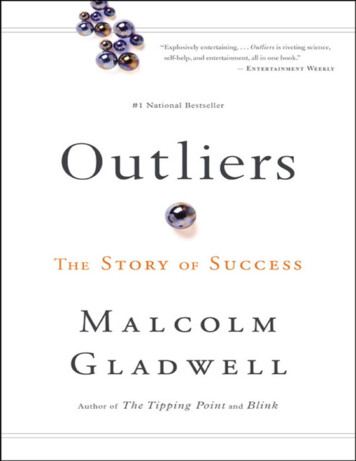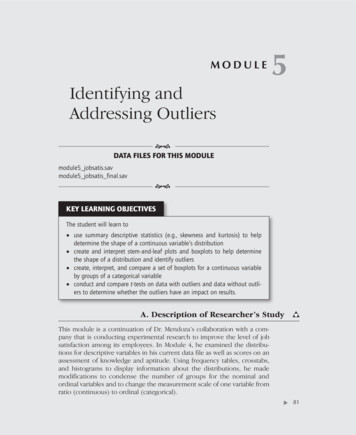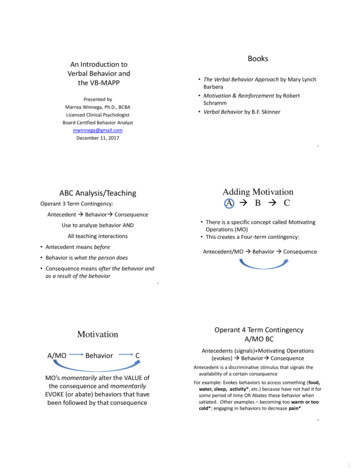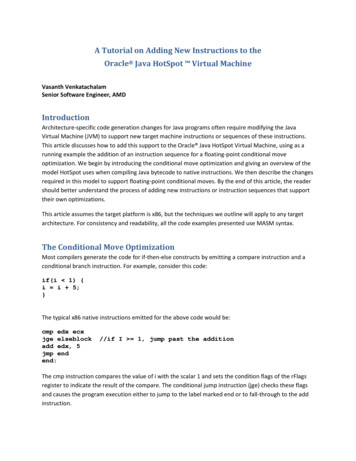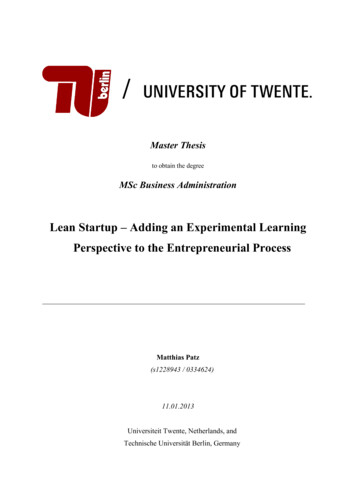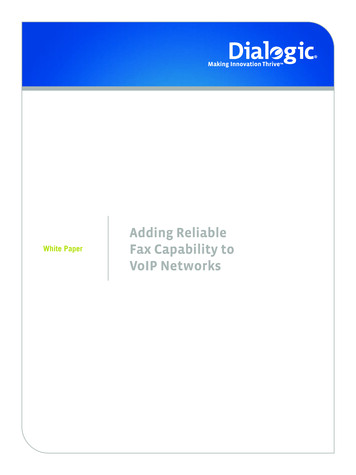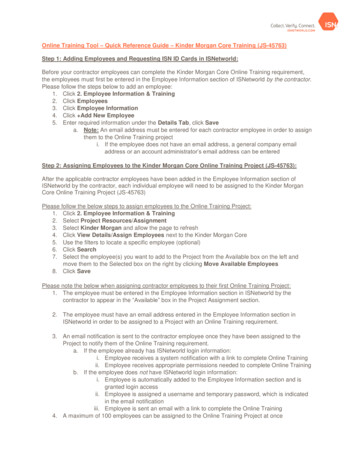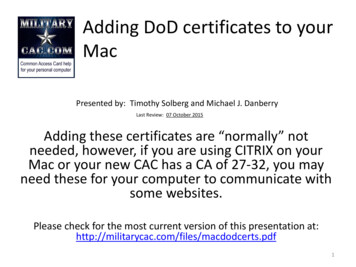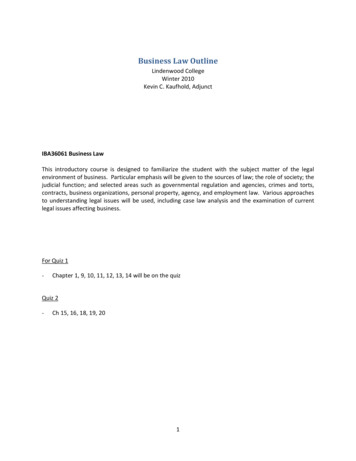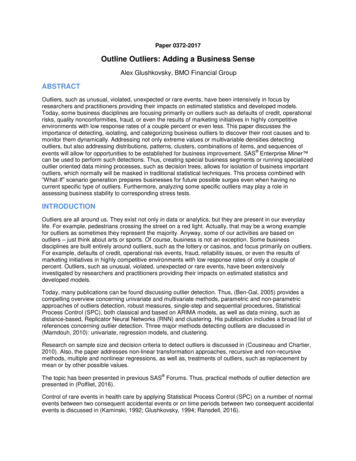
Transcription
Paper 0372-2017Outline Outliers: Adding a Business SenseAlex Glushkovsky, BMO Financial GroupABSTRACTOutliers, such as unusual, violated, unexpected or rare events, have been intensively in focus byresearchers and practitioners providing their impacts on estimated statistics and developed models.Today, some business disciplines are focusing primarily on outliers such as defaults of credit, operationalrisks, quality nonconformities, fraud, or even the results of marketing initiatives in highly competitiveenvironments with low response rates of a couple percent or even less. This paper discusses theimportance of detecting, isolating, and categorizing business outliers to discover their root causes and tomonitor them dynamically. Addressing not only extreme values or multivariable densities detectingoutliers, but also addressing distributions, patterns, clusters, combinations of items, and sequences of events will allow for opportunities to be established for business improvement. SAS Enterprise Miner can be used to perform such detections. Thus, creating special business segments or running specializedoutlier oriented data mining processes, such as decision trees, allows for isolation of business importantoutliers, which normally will be masked in traditional statistical techniques. This process combined with“What-If” scenario generation prepares businesses for future possible surges even when having nocurrent specific type of outliers. Furthermore, analyzing some specific outliers may play a role inassessing business stability to corresponding stress tests.INTRODUCTIONOutliers are all around us. They exist not only in data or analytics, but they are present in our everydaylife. For example, pedestrians crossing the street on a red light. Actually, that may be a wrong examplefor outliers as sometimes they represent the majority. Anyway, some of our activities are based onoutliers – just think about arts or sports. Of course, business is not an exception. Some businessdisciplines are built entirely around outliers, such as the lottery or casinos, and focus primarily on outliers.For example, defaults of credit, operational risk events, fraud, reliability issues, or even the results ofmarketing initiatives in highly competitive environments with low response rates of only a couple ofpercent. Outliers, such as unusual, violated, unexpected or rare events, have been extensivelyinvestigated by researchers and practitioners providing their impacts on estimated statistics anddeveloped models.Today, many publications can be found discussing outlier detection. Thus, (Ben-Gal, 2005) provides acompelling overview concerning univariate and multivariate methods, parametric and non-parametricapproaches of outliers detection, robust measures, single-step and sequential procedures, StatisticalProcess Control (SPC), both classical and based on ARIMA models, as well as data mining, such asdistance-based, Replicator Neural Networks (RNN) and clustering. His publication includes a broad list ofreferences concerning outlier detection. Three major methods detecting outliers are discussed in(Mamdouh, 2010): univariate, regression models, and clustering.Research on sample size and decision criteria to detect outliers is discussed in (Cousineau and Chartier,2010). Also, the paper addresses non-linear transformation approaches, recursive and non-recursivemethods, multiple and nonlinear regressions, as well as, treatments of outliers, such as replacement bymean or by other possible values. The topic has been presented in previous SAS Forums. Thus, practical methods of outlier detection arepresented in (Polfliet, 2016).Control of rare events in health care by applying Statistical Process Control (SPC) on a number of normalevents between two consequent accidental events or on time periods between two consequent accidentalevents is discussed in (Kaminski, 1992; Glushkovsky, 1994; Ransdell, 2016).
Commonly, there are conflicting requirements to have sufficient sample sizes to build robust statisticalanalysis or models and extremely limited information concerning outliers. Even though, the modern “bigdata” trend of storing a lot of data means that sample sizes of outliers are not too small anymore, butdealing with outliers is still very challenging, starting with their identification, and requires business judgement combined with analytical approaches. Practically, SAS Enterprise Guide and SASEnterprise Miner can be used to perform outlier detections.The paper discusses the importance to not ignore or automatically filter or replace outliers, but to detect,to isolate, and to classify business sound outliers, to discover their predictive factors (i.e., root causes),and to monitor them dynamically.The article is not a comprehensive overview or introduction of some methodologies to detect outliers;rather it is a view on possible analytical approaches toward outliers and their roles in businessimprovement.CLASSIFICATION OF OUTLIERSThere are a number of definitions of outliers (Weisberg, 1985; Barnet, 1994). Traditionally we candescribe outliers by the following not mutually exclusive terms: Rare Unusual Uncommon Unexpected Violated ErrorOutliers can be identified by their extreme values, by their low frequencies, or by rare events. Thus, a rareoutlier can be revealed to a low frequency or to a low probability density, unusual or uncommon ones canbe associated to a shortfall or a large distance value, an unexpected outlier can be related to a largeresidual of the model or to a significant error of the estimation, a violated outlier can be judged against thedefined specifications, and an error can be caused by a typo or inconsistencies, mostly logical.For example, the tail of the distribution usually has a low probability density (infrequent) and theobservations there possess extreme values (unusual). This is quite a common dependence.Different, not mutually exclusive, and “fuzzy” definitions mean difficulties identifying outliers using differentanalytical techniques, shortfalls understanding their triggers and causes, and lack of monitoring.Nevertheless, some generalized view can be presented covering different definitions of outliers.Focusing on business sense, two mutually excluding categories of outliers can be defined: Inherent ErrorAn inherent outlier means that it possesses a distinctly different property from the rest of the elements(Hawkins, 1980) but can be present due to the nature of the business. Therefore, it is “organic” for thebusiness. In contrast, any error can be recognized as an outlier and it is not acceptable and ideally shouldbe fixed and prevented from occurring again in the future. Inherent outliers may have a positive ornegative impact on a business. In the article, we will focus on outliers that create opportunities for abusiness improvement leaving outliers with neutral impacts on a business out of scope.In business, one of the major goals is to implement improvement changes, i.e., boosting positivevariances while blocking and preventing negative ones (Shewhart and Deming, 2012). The fundamental
idea of Statistical Process Control (SPC) is a distinction between assignable and common variances(Juran and Godfrey, 1999; Duncan, 1986; Montgomery, 2005, Woodall, 1986). Identified distinctionbetween common and assignable variances allows for initiation of improvement programs. Looking atoutliers from such a prism allows us to view them as assignable variances. It means that out-of-controlsignals dynamically identify outliers with respect to historical observations. Furthermore, as an example, itmeans that extreme values are not necessarily outliers if they are not assignable variances.The link between SPC and outliers is not a new paradigm and has already been discussed (Ben-Gal,2005).A list of possible outliers in business may include traditional objects such as variable values, includingmissing ones, events, records, clusters, and samples as well as non-traditional objects, such as: Distributions Patterns Combinations of items (baskets) Sequences of events ModelsAddressing not just extreme values or multivariable densities detecting outliers, but objects such as thoselisted above that are conditioned to be assignable variances, will open more opportunities for businessimprovements.Moreover, assignable variances may even include the following examples: Optimization points of the objective functions. For example, pricing that maximizes profit Extraordinary features of products, services, or processes Non-dominated strategies that form Nash equilibrium Efficient frontier, which is a set of outliersThe critical element detecting inherent assignable outliers is the clear business sense accompanied by asignificance to deviate from core elements possessing common variances.In general, adding business sense to outliers and focusing on improvements always requires tworelationships to be discovered: (1) between outliers and their root causes, and (2) between outliers andbusiness sound target variables, i.e., Key Performance Indicators (KPIs). The latest should be definedbased on business objectives. Essentially, business sound outliers either impact target variables directlyor influence drivers of the target variable. Moreover, assignable outliers usually have leveraged effects onbusiness results. Considering the sample sizes of the outliers, that chain of relationships, in most cases,is a very challenging task to be discovered.IMPROVEMENT CYCLE DRIVEN BY OUTLIERSThe improvement cycle based on outliers includes five major elements (see Fig. 1) and it is quite similarto the classical Deming - Shewhart’s continual improvement PDSA cycle (Deming, 2010; Shewhart andDeming, 2012).
icationIdentificationof RootCausesFigure 1. Outlier Based Business Improvement CycleLogically, the first two steps of the cycle are detection of assignable outliers and the classification of themas inherent ones or errors. The detection step can be done deterministically using business knowledgefor obvious cases or analytically while still applying sound business judgement. Assignable outliers canthen be analyzed further to understand their underlying causes which may lead to improvements. Thiscan be done by applying root-cause analysis supported by data mining or machine learning techniquesfocusing on possible drivers.Generally, root causes can be triggered by changes in macroeconomic or market environments,competitor initiatives, regulations, or inner business matters.(SM)By analogy to Capability Maturity Model (CMMoutliers can be defined as:) (Paulk et al, 1993), levels of business interaction with Ignorance (pay no attention, no detections, no isolations) Detection (ad hock removal or replacement) Control (implementation of special tools such as SPC) Management (establishment of improvement actions) Optimization (systematic and integrative improvement processes toward a business goal in aconstrained environment)Common mechanisms dealing with outliers today are simple observations during reporting or theirremoval during data preparations for modeling (level I and II), and data quality management routinesmostly during data inputs and loadings (levels II - IV). Higher levels of business interaction with outliersrequire an enterprise wide involvement.The most mature level V of dealing with outliers perhaps can be observed in . . . nature (see Figure 2).The climbing plant actually applies the continues improvement strategy by spreading outliers in differentdirections, checking the outcomes, and then selecting the most beneficial one for future growth.
OutliersFigure 2. Utilization of “Outliers” Is a Natural Growing Mechanism of the Climbing Plant.OUTLIERS AND ANALYTICAL APPROACHESCommon analytical objectives are to estimate statistics or parameters, to discover relationships, to score,to predict, to detect common patterns, to discriminate, or to classify. All those listed above can be affectedby outliers. From another side, analytical approaches can be used to detect outliers and their root-causes.Here is a list of some analytical approaches, which may be helpful in detecting outliers: Associations Clustering SPC Neural networks Regressions Decision treesThe last three models may be used for root-cause identifications as well. However, the neural networksapproach is not transparent since it consists of a lot of elementary models and, therefore, the obtainedresults cannot be drilled down by variables or segments getting more insights on business issues.OUTLIERS AND MODELSThere are three-way relationships between models and outliers as presented in Figure 3.Modeling is a well-known and an effective mechanism to detect outliers (Weisberg, 1985; Mamdouh ,2010). On the another hand, model quality itself can be impacted by outliers. Research on the influenceof outliers on the quality of predictive classifying models, including decision trees, and comparison toother models, such as kNN, Naïve Bayes, and logistic regression, is described in (Kalisch et al, 2016).
ModelsImpactDetection IdentificationOutliersRootcausesFigure 3. Relationships between Outliers and ModelsThe impact of outliers on a model can arise during training as well as during the usage of the trainedmodel. Both effects should be in focus. The latest can be handled by setting a monitoring process of theimplemented model quality and its inputs. It will allow for detection of changes due to an outlier’spresence.Outliers can exist in target variables as well as in potentially predictive inputs, or both.Outliers in the target variable should always be specially treated since they represent direct businesscases. Of course, the presence of outliers in the binary target variable cannot be detected directly.Outliers of interval, nominal, or ordinal target variables can be handled by applying simple segmentationto isolate them based on business judgement or uni
Associations Clustering SPC Neural networks Regressions Decision trees The last three models may be used for root-cause identifications as well. However, the neural networks approach is not transparent since it consists of a lot of elementary models and, therefore, the obtained results cannot be drilled down by variables or segments getting more insights on business issues. OUTLIERS AND MODELS .
